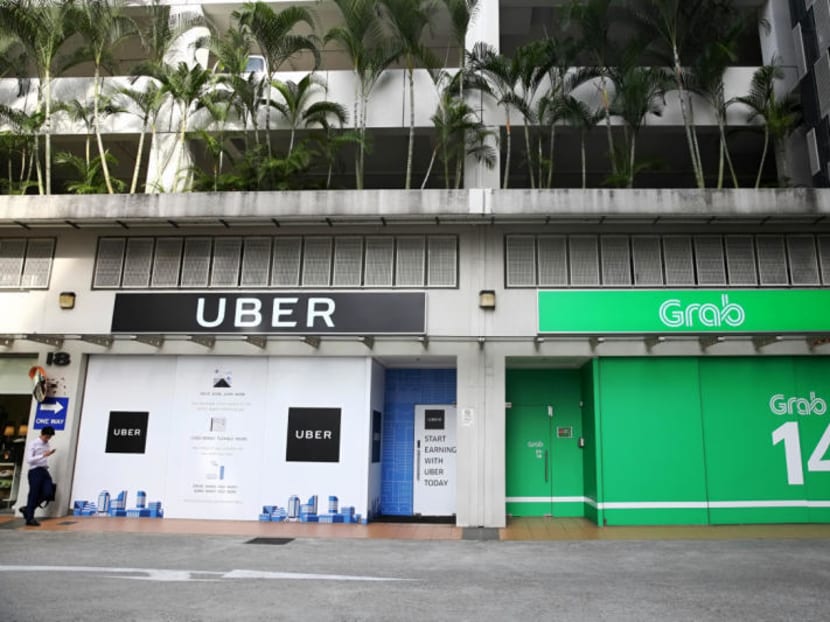Monopoly could hurt private-hire customers; Fares, fleet sizes among areas to regulate: Experts
SINGAPORE — Ride-hailing firms’ fares, fleet sizes, and service levels could come under regulatory scrutiny as the authorities mull over how to license operators Grab and Uber, said transport experts. With news emerging last month that Uber was preparing to sell its South-east Asia business to Grab, they also pointed to the potential pitfalls of a monopoly here, as that could lead to a dominant player abusing its market power and raising prices.
SINGAPORE — Ride-hailing firms’ fares, fleet sizes, and service levels could come under regulatory scrutiny as the authorities mull over how to license operators Grab and Uber, said transport experts. With news emerging last month that Uber was preparing to sell its South-east Asia business to Grab, they also pointed to the potential pitfalls of a monopoly here, as that could lead to a dominant player abusing its market power and raising prices.
On Wednesday (March 7), Second Transport Minister Ng Chee Meng announced that the Government will review the regulations governing the point-to-point transport sector, so that no single player will dominate. He noted that the Government had taken a minimal regulatory approach towards the private-hire car industry to avoid stifling innovation, but it has since grown and changed point-to-point transport considerably.
The review will look into how to license ride-hailing companies and structure the industry, Mr Ng said during the Transport Ministry’s budget debate in Parliament.
Transport economist Walter Theseira of the Singapore University of Social Sciences (SUSS) said one option is to regulate operators’ vehicle fleets, which has been the case for taxi operators. Taxi fleets are currently subject to a 2 per cent growth cap yearly, provided operators meet availability standards.
The intent of such caps is to create a sustainable market so that there will not be an oversupply or undersupply of vehicles, said Dr Theseira.
Pricing is another area that can be examined. Just like the taxi industry, where fares were deregulated in 1998 to allow operators to set their own prices, Dr Theseira said that though the Government will not set prices, it can set the conditions governing how commuters are charged.
Given that ride-hailing operators hold information on customers, it is “entirely conceivable that in the future they can charge different people different prices”, said Dr Theseira. He added that operators are already practising that by offering varying discounts to different groups of commuters.
Assistant Professor Terence Fan, a transport specialist with the Singapore Management University (SMU), said a merger of various operators to form a single “big player” — as would be the case if Uber’s sale to Grab comes through — will be a bane for commuters, as prices will go up.
As bookings are subject to dynamic pricing, where fares rise when demand goes up, Dr Theseira said commuters and regulators have little insight into what determines prices. “That greatly increases the potential for pricing practices that might violate our sense of what’s fair,” said Dr Theseira. “More information about business practices has to be opened up as part of this (review).”
He also added that the different levels of service, such as priority allocation of rides for Grab’s platinum customers, also “breaks a basic rule of public transport operations”.
A tighter regulatory regime could also reduce operators’ ability to discriminate in terms of price, added Dr Theseira. Operators would also be concerned if the Government tried to stop further market consolidation, as some believe this is the only way the market can turn profitable.
However, Asst Prof Fan said the licensing regime should not be too onerous for new players to enter the market. “If you have no new entrants, then of course the industry may consolidate to a point where it may harm consumers’ interests,” he added.
SUSS’ urban transport expert Park Byung Joon suggested looking into the number of private-hire car drivers operators can recruit, as that is currently not capped. He said that having too many drivers in the market may not augur well for their livelihoods. According to the latest official data, there are more than 40,000 private-hire car drivers and 96,000 licensed taxi drivers here.
Experts said that capping the pool of vehicles and drivers could reduce disruptive competition between the ride-hailing operators, allowing them to compete on service quality instead of sheer size.
When contacted, Grab and Uber said they will work with the authorities to improve the sector.
Mr Warren Tseng, general manager of Uber Singapore and Malaysia, said: “We look forward to working with the Singapore Government to continue improving the private-hire car industry in ways that encourage growth and innovation, while maintaining safety and reliability.”
A spokesperson for Grab added: “We have always prioritised advancing the interests of our customers, above and beyond requirements, and will continue to do so… We look forward to working closely with the Land Transport Authority to ensure the ride-hailing industry caters to commuting needs and complements the public-transport network in Singapore.”









